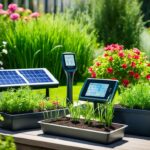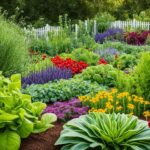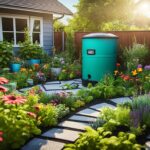“organic gardening methods”
Companion Planting for Small Vegetable Gardens: Boost Growth and Deter Pests
Ever thought about making your small garden a place of growth and balance? Companion planting is the key to unlocking your garden’s full potential. It’s an old trick that pairs plants together to fight pests and boost health.
But what makes this method work? How can you use it to make your garden thrive with little effort? Let’s dive into the world of companion planting for small gardens and find out.
Key Takeaways
- Companion planting is the strategic pairing of plants to create mutually beneficial relationships in your garden.
- This technique can deter pests, attract beneficial insects, improve soil fertility, and increase overall plant yields.
- Companion planting is especially valuable for small gardens, where space is limited, and every square inch counts.
- By understanding the unique properties and interactions of different plants, you can cultivate a thriving, low-maintenance garden.
- Companion planting is a key strategy in organic and sustainable gardening practices, allowing you to grow a bountiful harvest while minimizing the use of harmful chemicals.
What is Companion Planting?
Companion planting is a way to grow different plants together. It uses the natural interactions between plants to help each other. This makes your vegetable garden healthier and more productive.
The idea behind companion planting is simple. Some plants help others by fighting pests, making soil better, or growing together well. This can be one-way, where one plant helps another. Or it can be like the Three Sisters method, where corn, beans, and squash help each other grow.
The Benefits of Companion Planting
Pairing plants can bring many benefits. Here are some:
- Deterring pests: Mixing crops makes it hard for pests to find their favorite plants.
- Attracting beneficial insects: Some plants draw in insects that eat garden pests, controlling them naturally.
- Regulating shade and support: Taller plants can shade and support shorter ones.
- Improving soil fertility: Some plants fix nitrogen or loosen hard soil, helping their neighbors.
- Suppressing weeds: Plants grown close together can block weeds, cutting down on weeding.
Adding companion plants to your vegetable garden boosts its health and productivity. By knowing how plants work together, you can make a garden that’s full of life and growth.
Benefits of Companion Planting
Companion planting in your vegetable garden has many benefits. It helps keep pests away and attracts helpful insects. By mixing different plants, you create a healthy garden that supports your plants well.
Deterring Pests
One big plus of companion planting is it keeps pests away. Mixing plants makes it hard for pests to find their targets. This means you use fewer chemicals and grow your veggies naturally.
Attracting Beneficial Insects
Some plants draw in good bugs like ladybugs and wasps that eat garden pests. By offering a home and food, you encourage these helpful insects to stay. This boosts your pest control with companion plants.
Improved Plant Health and Soil Fertility
Companion planting also makes your plants healthier and more productive. Some plants offer support, control shade, and enrich the soil. Others help stop weeds from growing, giving your veggies more room to thrive.
Using companion planting leads to a garden full of life and less need for chemicals. It brings in beneficial insects and makes your soil richer. This way, you get healthier plants and a bigger harvest.
Companion Planting for Small Gardens
Companion planting is great for gardeners with little space, like those with small vegetable gardens. In these tight spots, you can grow companion plants in pots or between vegetable rows. This way, you get pest control, more pollinators, and bigger harvests without using up too much space. It’s a smart way to make the most of every inch in your garden.
Growing Companion Plants in Pots
Container gardening is a big help for companion planting in small gardens. Many plants do well in pots and can be placed right next to your veggies. This saves space and lets you control the soil and sunlight for both the plants and your veggies.
Interplanting Companion Plants
Interplanting is another smart move for small gardens. By placing complementary plants between your veggies, you create a balanced garden. This method keeps pests away, draws in good bugs, and boosts plant health. It’s a clever way to use every bit of your garden space.
“The key to successful companion planting in small gardens is to choose compact, space-saving varieties and arrange them strategically to maximize the benefits.”
Whether you’re using pots or interplanting, the secret to success is picking plants that save space and arranging them well. By adding companion planting to your small garden, you can have a lush, productive, and pest-free garden, even in tiny spaces.
Plants to Attract Pollinators
Plants that attract pollinators are key in vegetable gardens. They help crops like tomatoes and peppers produce more fruit. By placing these plants near vegetables, gardeners can boost pollination. This leads to bigger harvests and better-quality food.
Annual flowers like borage, zinnia, and cosmos draw bees and butterflies. Perennials such as bee balm and lavender also attract pollinators. These plants are pretty and provide food for pollinators, enhancing garden pollination.
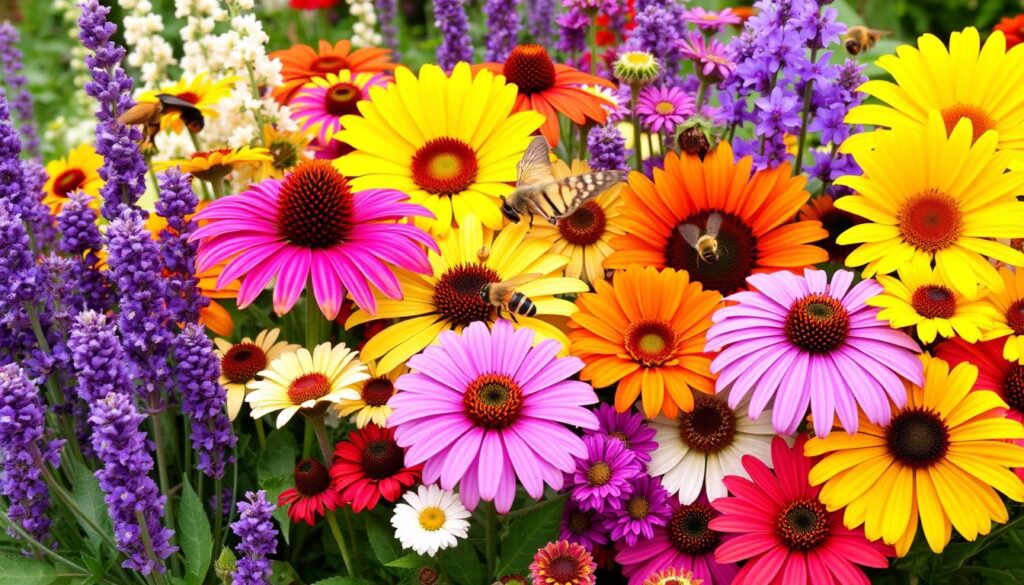
When planning your garden, add a mix of annual and perennial flowers that attract pollinators. This will make your garden healthier and more productive. You’ll get a lot of fresh, nutritious food.
| Annual Flowers for Pollinators | Perennial Flowers for Pollinators |
|---|---|
|
|
“By attracting a diverse array of pollinators to your vegetable garden, you’ll not only enjoy a more productive harvest but also contribute to the overall health of your local ecosystem.”
Plants for Pest Control
Gardeners can use companion plants for a natural pest control in small vegetable plots. These plants help by keeping pests away and bringing in beneficial insects. These insects eat common garden pests.
Repelling Pests with Fragrant Herbs
Some herbs like sage, rosemary, and garlic keep pests away. Their strong smells can chase off insects and animals like deer and rabbits. This protects your vegetables.
Distracting Pests with Trap Crops
Trap crops draw pests away from your main plants. Nasturtiums and radishes are great for this. They attract pests like aphids and cucumber beetles, keeping them away from your vegetables.
Attracting Beneficial Insects
Plants like dill and sweet alyssum attract helpful insects. Ladybugs and wasps come to these flowers and eat pests. This keeps the garden balanced and cuts down on the need for harmful chemicals.
Using different companion plants makes a garden a natural pest control system. These plants keep pests away, distract them, and bring in their enemies. This creates a healthy garden environment.
Companion Planting Examples
Companion planting is key for small vegetable gardens. It helps keep pests away and makes plants grow better. A top pair is basil and tomatoes. Basil’s strong smell keeps pests like thrips and moths away from tomatoes.
Marigolds are another great choice for companion planting. They keep pests like nematodes away from many vegetables. Adding these bright flowers to your garden helps control pests naturally. This makes your garden healthy and easy to care for.
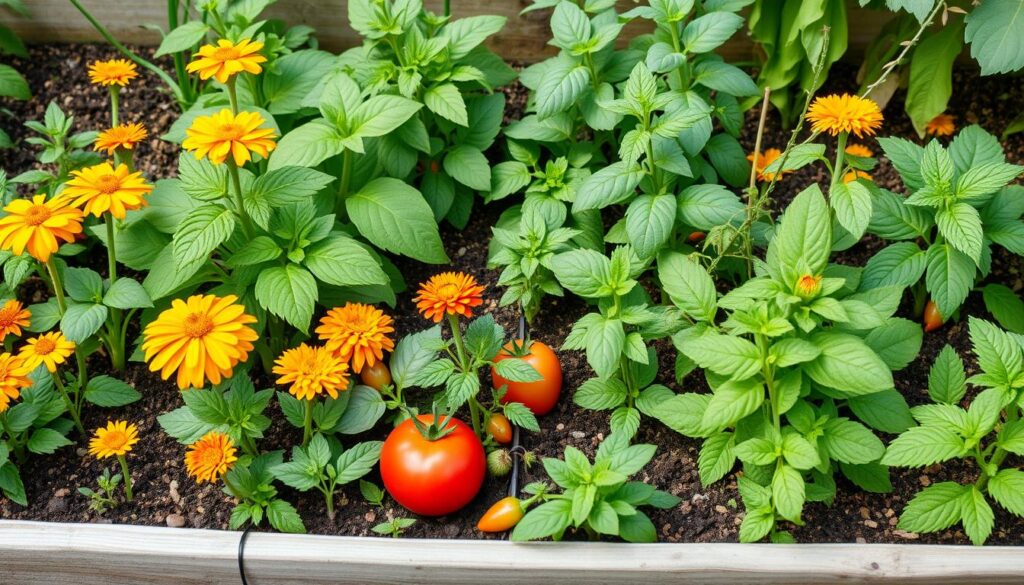
“Companion planting is a time-tested technique that allows gardeners to create a diverse, thriving ecosystem right in their own backyards.”
By knowing how different plants work together, you can make a garden that looks good and fights pests. Planting basil with tomatoes or marigolds with other veggies is a smart move. Companion planting is a big win for your garden’s health and productivity.
Companion planting for small gardens
When using companion planting in a small garden, planning is crucial. Pick compact vegetables and grow them with other plants in pots. This way, you get a garden that’s full of life and doesn’t take up too much space.
Compact Companions for Cozy Corners
Find space-saving gardening techniques and pick compact vegetable varieties that fit well in small spaces. Pair these with other plants that grow well in pots or together. This method helps with pest control, better soil, and more pollinators without using up too much space.
Potted Pairings for Patio Perfection
Using pots is a great way to grow plants in small gardens. Put herbs, flowers, and legumes in pots around your vegetables. This saves space and lets you control how plants work together.
| Compact Vegetable Varieties | Companion Plants for Pots |
|---|---|
| Bush Beans | Marigolds, Radishes |
| Cherry Tomatoes | Basil, Chives |
| Dwarf Peppers | Nasturtiums, Parsley |
Plan and arrange your plants carefully to make a small garden that’s both beautiful and productive. It uses the power of plants working together to improve your garden.
The Science Behind Companion Planting
As a savvy gardener, you’ll be happy to learn that companion planting is now supported by science. This approach is proven to be effective in the garden. It offers a natural way to manage pests without harsh chemicals.
Studies reveal that some plants work together to reduce pests. For example, herbs with strong smells can keep pests away. They release compounds that insects find unappealing.
Other plants act as “trap crops.” They draw pests away from the main crops, acting as a decoy. This helps protect the plants you want to grow.
Flowering plants also play a role by attracting beneficial insects. Ladybugs and parasitic wasps are drawn to these flowers. They then help control pests in the garden. This shows that companion planting is a smart way to keep pests at bay naturally.
FAQ
What is companion planting?
Companion planting means growing different plants together to help each other out. This can make plants grow better, keep pests away, and increase the amount of food you get from your garden.
What are the benefits of companion planting?
Growing plants together has many perks. It keeps pests away, draws in good bugs, controls shade, offers natural support, boosts plant health, enriches the soil, and fights weeds.
How can companion planting be used in small vegetable gardens?
In small gardens, you can use companion plants in pots or mix them with vegetables. This saves space and makes the most of your garden area. It helps you enjoy the benefits of companion planting without losing valuable space.
What plants can be used to attract pollinators?
Plants like borage, zinnia, and cosmos attract bees and butterflies. Perennials like bee balm and lavender also draw in pollinators to your garden.
What companion plants can be used for pest control?
Herbs like sage, rosemary, and garlic keep insects away with their strong smells. Trap crops like nasturtiums and radishes pull pests away from your main crops. Flowers like dill and sweet alyssum bring in beneficial insects that eat garden pests.
Can companion planting be backed by scientific research?
Yes, science now supports companion planting. Studies show that some plant pairs can reduce pests by repelling them, distracting them, or attracting beneficial insects.
Source Links
- Companion Planting Chart and Guide for Vegetable Gardens – https://www.almanac.com/companion-planting-guide-vegetables
- Companion Planting for the Veggie Garden – https://www.gooseberrygardens.ca/post/companion-planting-for-the-veggie-garden
- Companion Gardening Guide: Companion Planting for Garden Pest Control – https://zerowastehomestead.com/companion-gardening-guide-how-to-use-companion-planting-for-garden-pest-control/
Using Technology to Enhance Sustainable Gardening
Technology is changing every part of our lives, including gardening. You might ask, “How can tech help make my garden more sustainable and efficient?” The answer is in new solutions that are changing how we garden.
Smart gardening tools and precision agriculture are here to change the game. This article will show you how technology can make your garden better. It will help you create a garden that’s good for you and the planet.
Key Takeaways
- Discover innovative smart gardening tools that automate tasks and improve efficiency
- Learn how to leverage data and AI for smarter garden planning and predictive maintenance
- Explore eco-friendly landscaping options and solar-powered gardening tools
- Understand how precision agriculture techniques can optimize your garden’s yield and efficiency
- Discover the benefits of vertical farming and personalized garden services
Are you ready to make your garden better with technology? Let’s explore the new innovations in sustainable gardening.
Smart Gardening Tools and Automation
In today’s digital world, smart gardening tools are changing how we care for our gardens. They give us real-time info on soil health, moisture, and more. This helps homeowners and garden pros make better choices and automate gardening tasks.
Real-time Data and Automated Features
Smart gardening tools come with sensors and can connect to the internet. They let you check on your plants and soil nutrients right from your phone. With these tools, you can save time and make sure your garden stays healthy with less work.
Features like self-driving lawn mowers and automated pruning are making gardening easier. The future of gardening looks like it will be more about relaxing and enjoying the results.
AI Garden Planning and Predictive Maintenance
Artificial intelligence (AI) is now a big part of garden planning and maintenance. AI looks at your garden’s specific needs, soil, and weather to give you tailored advice on what to plant and when. It can also spot problems like pests or diseases before they start.
This means you can keep your garden looking great with less hassle. AI helps you stay ahead, ensuring your garden stays lush and healthy.
“Smart gardening tools are transforming the way we interact with our outdoor spaces, making gardening more efficient, convenient, and sustainable than ever before.”
Sustainable Landscaping and Eco-Friendliness
The gardening world is going green, using eco-friendly materials, native plants, and natural fertilizers. We’re also cutting down on water use and using solar-powered or electric gardening tools. These changes help the planet and save money on upkeep.
Eco-friendly Materials and Native Plants
Choosing the right materials is key for a green garden. Use recycled or renewable stuff like recycled plastic, bamboo, or reclaimed wood for beds, paths, and more. Adding native plants helps local wildlife and cuts down on water and chemicals.
Solar-Powered and Electric Gardening Tools
Using renewable energy for your gardening tools is a smart move. Solar-powered mowers and trimmers cut down on gas and electricity use. Electric gardening tools with rechargeable batteries are also a great choice.
| Sustainable Landscaping Feature | Benefits |
|---|---|
| Eco-friendly materials | Reduced environmental impact, lower maintenance costs |
| Native plants | Attract local wildlife, require less water and maintenance |
| Solar-powered and electric tools | Renewable energy sources, reduced carbon emissions, lower operating costs |
Adding these green practices to your garden makes it beautiful and helps the planet. It’s a win-win for you and the environment.
gardening technology
Technology has changed the game in modern gardening. It makes lawn care, hedge trimming, and weed control easier. No more manual labor or spending hours on tasks. Gardening technology brings efficiency, sustainability, and accessibility to our gardens.
Now, you can book lawn mowing and trimming online. Smart gardening tools automate routine tasks. This tech revolution lets homeowners manage their gardens easily, saving time for other hobbies.
But there’s more. Modern gardening tools like robotic lawnmowers and high-tech chainsaws are getting popular. With repair services and online tutorials, maintaining these tools is simple. This lets homeowners take charge of their gardens.
“Technology has revolutionized the way we approach gardening, making it more efficient, sustainable, and accessible than ever before.”
These new tools are changing gardening for the better. They help us garden sustainably and reduce our environmental impact. Tools and systems like energy-efficient ones and automated watering systems are making gardens greener and healthier.
The digital age is opening up new possibilities in gardening. Whether you’re an expert or new to gardening, today’s modern gardening tools and services are changing how we garden and enjoy our outdoor spaces.
Precision Agriculture: Optimizing Yield and Efficiency
Precision agriculture is changing the game in sustainable gardening and farming. It uses advanced tech to boost crop yield and use resources better. This leads to a greener future. At its core are GPS mapping and remote sensing, which are changing how we manage land.
GPS Mapping and Remote Sensing
GPS mapping gives gardeners and farmers exact field details and topography. This lets them adjust their methods for each area’s needs. It cuts down on waste and makes the most of every piece of land.
Remote sensing adds to this with tools like satellite images and drones. These give real-time updates on crops, soil, and weather. This info helps gardeners and farmers make smart choices for better yields and gardening.
Data Analytics for Strategic Insights
Data analytics boosts the power of precision agriculture. It turns big data into insights that guide planting, watering, and fighting pests. This approach increases yield optimization and efficient gardening, reducing waste and saving resources.
Precision agriculture is a bright spot in the quest for sustainable food. It combines GPS, remote sensing, and data analytics. This approach is changing how we farm and manage land, leading to better efficient gardening and yield optimization in the future.
Vertical Farming: A Solution for Urban Agriculture
As cities grow and we need more food, vertical farming is becoming key. It lets us grow crops up high, making the most of small city spaces. This way, we use less land and hurt the environment less.
Vertical farms use cool tech like hydroponics and aeroponics to feed plants well. They use much less water than old-school farms. This means we get fresh, healthy food all year, not just when it’s in season.
| Benefit | Impact |
|---|---|
| Water conservation | Vertical farms can use up to 95% less water than traditional agriculture. |
| Year-round production | Vertical farms can grow crops in a controlled environment, independent of seasonal fluctuations. |
| Reduced carbon footprint | Vertical farms minimize the need for long-distance transportation, cutting down on greenhouse gas emissions. |
Some vertical farms even use solar power, making them even greener. This makes urban agriculture and vertical farming more eco-friendly. As cities get bigger, vertical farming is a big part of the solution for feeding the future.
“Vertical farming is not just about growing food – it’s about growing a more sustainable future for our cities.”
Personalized Garden Services and Virtual Tours
The gardening world has changed a lot with technology. Now, garden services offer personalized solutions and virtual tours. They meet the unique needs and likes of their clients, making gardening fit their lives.
These services are not just about the usual gardening work. They offer everything from custom garden designs and landscaping to detailed care and lots of plants. With the latest tech, they even provide 3D garden models or virtual tours. This lets homeowners see their dream gardens before they start.
Personalized gardening aims to give each client a special experience. It looks at what each person likes, their budget, and the planet. This way, every garden shows off the homeowner’s style and needs. It uses eco-friendly stuff and plants that are native, making a beautiful and green oasis.
Whether you know a lot about gardening or are just starting, these services and tours can change your outdoor area. They help you make the most of your garden and start a journey of gardening excellence.

| Service | Description |
|---|---|
| Custom Garden Design | Tailored layouts and plans that reflect your unique preferences and lifestyle |
| Eco-Friendly Landscaping | Sustainable materials and native plant selection for a harmonious outdoor space |
| Virtual Garden Tours | Immersive 3D models and online walkthroughs to envision your dream garden |
| Personalized Maintenance | Customized care and upkeep to ensure your garden thrives year-round |
Sharing Economy Approach to Gardening
The sharing economy has changed how we garden. Platforms like Parkbench, Neighborgoods, and Letgo let gardeners connect and share. This creates a team effort in gardening, making it easier for more people to garden while saving resources.
Communal Gardening and Resource Pooling
Gardeners no longer need to buy their own tools and equipment. They can use what’s shared in their community. This saves money and cuts down on waste by using things better.
People can share garden plots, seeds, and advice. This builds a strong network of gardeners who support each other.
This way of gardening fits well with wanting to be more green and caring for the planet. Sharing things means less waste and a smaller carbon footprint for everyone. It also brings people closer, creating a community feeling through gardening.
“The sharing economy has made gardening more accessible and inclusive than ever before. By pooling our resources, we’re not only saving money but also building stronger, more sustainable communities.”
Whether you’re new to gardening or have been doing it for years, the sharing economy has lots of perks. It makes gardening cheaper and connects you with others who share your interests. This new way of gardening is changing how we grow our gardens and build our communities.
Challenges and Opportunities in Agri-Tech Innovations
The world of agri-tech innovations is full of potential but also faces many challenges. These include poor rural infrastructure, digital literacy issues, and data privacy concerns. Yet, these challenges offer chances for new innovations and growth.
One big issue is the lack of good rural infrastructure. Without stable power, internet, and transport, many agri-tech solutions can’t reach those who need them most. This creates opportunities for companies working on renewable energy, smart irrigation, and better last-mile delivery.
Another challenge is getting traditional gardeners to try new things. We need strong digital literacy programs to teach gardeners about agri-tech’s benefits. By showing how these technologies can make farming better and increase yields, we can get more people to use them.
There are also big worries about data privacy. With agri-tech, there’s a lot of data that needs protecting. We must create strong data rules and clear policies on sharing data to build trust and encourage more innovation.
“As we confront global issues like climate change and food security, agri-tech proves to be an indispensable ally in our quest for a more sustainable and resilient future.”
Even with these challenges, the agri-tech industry has huge opportunities. By improving rural infrastructure, teaching digital skills, and protecting data, we can make the most of these technologies. This will lead to a more sustainable, efficient, and strong farming world.
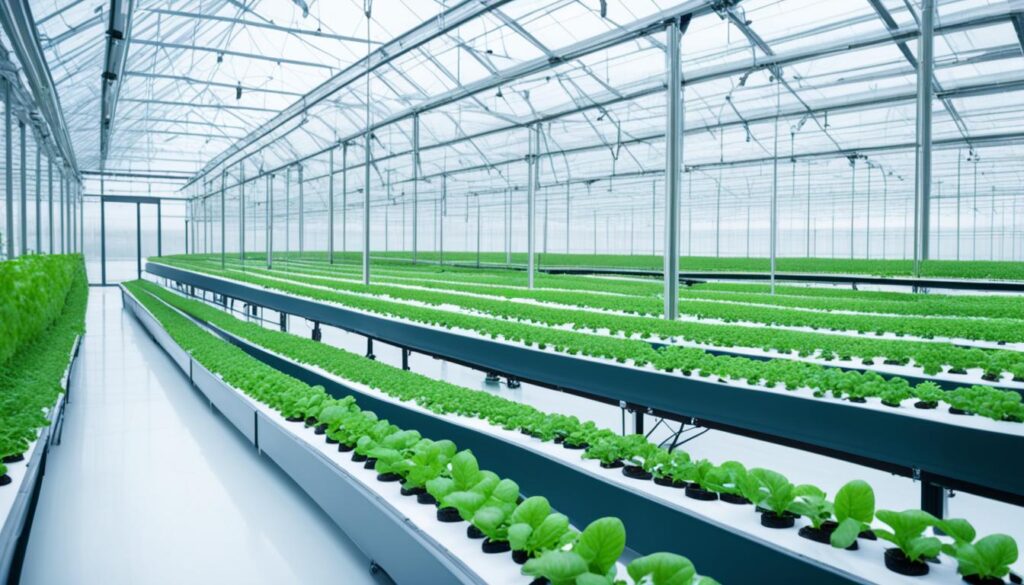
Conclusion
Gardening technology is changing the future for the better. It uses AI, machine learning, drones, precision agriculture, and vertical farming. These tools make gardening more efficient, reduce waste, and use resources wisely. They help us take care of our gardens while protecting the planet.
Even though there are challenges like poor infrastructure and resistance to new ideas, these issues also bring chances for more innovation and learning. By using these new technologies, you can change how we garden at home. Soon, taking care of plants will be easier, and smart garden management and urban gardening will be the standard.
The future of gardening looks bright. Eco-friendly gardening and sustainable gardening are becoming more popular thanks to advanced technology. Let’s welcome this future and watch our gardens grow with the help of technology.
FAQ
What are some of the key trends in smart gardening technology?
Smart gardening tools now give real-time info on soil quality, moisture, and plant health. They also automate tasks like mowing and watering. New tech like AI helps plan gardens and predict maintenance needs.
How is sustainable landscaping transforming the gardening industry?
Sustainable landscaping uses eco-friendly materials and native plants. It also means using natural fertilizers and saving water. Plus, it includes tools powered by solar or electricity to cut down on environmental harm and costs.
What are the benefits of precision agriculture in gardening?
Precision agriculture uses GPS, remote sensing, and data analysis to improve crop yields and use resources better. This helps gardeners and farmers plan better, manage water and pests, and grow more efficiently.
How is vertical farming revolutionizing urban agriculture?
Vertical farming stacks crops in urban areas, cutting down on transportation and using tech like hydroponics. This method gives plants what they need while saving water.
What are the advantages of personalized garden services and virtual tours?
Personalized garden services tailor solutions to each client, from design to maintenance. They also offer 3D models or virtual tours. This gives a unique gardening experience that meets individual needs and tastes.
How can the sharing economy approach benefit gardening enthusiasts?
Sharing economy platforms let gardeners share tools and resources. This reduces waste, builds community, and makes gardening cheaper and more accessible.
What are some of the challenges and opportunities in the adoption of agri-tech innovations?
Challenges include poor rural infrastructure, resistance to new tech, and digital skills gaps. But, these issues also open doors for more innovation. Solutions for reliable infrastructure and education could promote agri-tech’s benefits.
Source Links
- https://sustainablereview.com/tech-innovations-in-sustainable-agriculture/ – Tech Innovations in Sustainable Agriculture — Sustainable Review
- https://verdenook.com/articles/future-of-sustainable-gardening-green-technologies-innovations – Unveiling the Evolution of Sustainable Gardening: Green Technologies & Innovations
- https://wearelikeminds.com/the-future-of-gardening-services-innovations-technology-and-sustainability/ – The Future of Gardening Services: Innovations, Technology, and Sustainability. – Like Minds
Companion Planting for Natural Pest Control
Are you tired of fighting garden pests with harsh chemicals? Companion planting is an old trick that uses plants to keep pests away naturally. It’s a way to control pests without using toxic pesticides. But how does it work, and which plants work best together? Let’s explore the secrets of using plants to control pests naturally.
Key Takeaways
- Companion planting uses plants to keep pests away naturally.
- Having many plants in your garden makes it hard for pests to find what they want.
- Herbs like mint, tansy, and wormwood keep pests away.
- Flowers like nasturtiums and marigolds bring in insects that eat pests.
- Planning your garden carefully can help you control pests naturally.
Understanding the Principles of Companion Planting
Creating a pest-resistant garden begins with the core principles of companion planting. The main idea is that plant diversity helps keep pests away. By mixing different flowers, herbs, and vegetables, you make it tough for pests to find a favorite spot.
More Plant Diversity Equals Fewer Pests
Diverse plants confuse pests with their different smells and looks. This makes it hard for pests to find their usual food. Also, a garden full of different plants is a home for beneficial insects. These include ladybugs, lacewings, and parasitic wasps that eat garden pests.
Creating a Habitat for Beneficial Insects
It’s important to have a lot of beneficial insects in your garden. They help keep pests away naturally. By adding flowers, herbs, and various plants, you make a place where these helpful insects can live and work well.
| Beneficial Insect | Pest Targeted |
|---|---|
| Ladybugs | Aphids, mealybugs, scale insects |
| Lacewings | Aphids, mites, thrips, leafhoppers |
| Parasitic Wasps | Caterpillars, aphids, whiteflies |
“A diverse garden provides a habitat for beneficial insects like ladybugs, lacewings, and parasitic wasps that prey on common garden pests.”
Herbs that Deter Pests
Gardeners can use aromatic herbs for natural pest control. These herbs make your garden tastier and keep pests away from your veggies and flowers.
Mint, Tansy, Catnip, Wormwood, and More
Mint, tansy, catnip, and wormwood keep pests away. Plant them near your veggies to make a natural barrier. But, be careful with mint and tansy as they can spread a lot.
Other herbs like dill, basil, parsley, fennel, and cilantro also repel pests. Mixing these herbs creates a strong system that keeps your garden healthy.
Allowing Vegetables to Flower
Letting your veggies flower is another good idea. This attracts beneficial insects like ladybugs and lacewings, which eat garden pests.
Using herbs, veggies, and beneficial insects together makes a garden that’s beautiful and full of life without pesticides.
Flowers for Attracting Beneficial Insects
Some flowers are great at drawing in good bugs that eat garden pests. These beneficial insect-attracting flowers are key in fighting pests naturally, cutting down on harmful chemicals.
Nasturtiums and Marigolds
Nasturtiums are called the “queen” of pest-fighting flowering companion plants. They keep pests away and work as a trap crop, pulling pests away from your veggies. Marigolds bring in ladybugs and lacewings, which eat garden pests. These flowers also protect against nematodes, tiny worms that harm plant roots.
Cosmos, Alyssum, and Flowering Vegetables
Cosmos and alyssum are great for beneficial insect-attracting flowers. They draw in pollinators and bugs that eat pests, keeping your garden balanced. Letting your veggies flower also brings in these helpful bugs for natural pest control.
| Flower | Beneficial Insects Attracted | Additional Benefits |
|---|---|---|
| Nasturtiums | Predatory insects, ladybugs | Act as a trap crop, deter pests |
| Marigolds | Ladybugs, lacewings | Protect against nematodes |
| Cosmos | Pollinators, predatory insects | Visually appealing, easy to grow |
| Alyssum | Predatory insects, parasitic wasps | Compact growth, cascading flowers |
Adding these beneficial insect-attracting flowers to your garden makes a natural, sustainable ecosystem. These flowering companion plants are not just pretty. They’re key to keeping your garden healthy and balanced.
Testing Companion Planting Combinations
Many recommended companion plant combinations exist, but testing them in your garden is key. What works in one spot might not work in another. By trying out different plant pairs, you can find the best natural pest control for your garden.
Herbs to Repel Cabbage Worms and Cabbage Loopers
Studies show that thyme, nasturtium, and onion work well together. They keep cabbage worms and cabbage loopers away from your cabbage and other brassicas. These herbs form a natural barrier to protect your plants.
Herbs for Squash Bug and Tomato Hornworm
Marigold and nasturtium stop squash bugs, while basil and thyme keep tomato hornworms and armyworms away. Adding these plants to your garden helps control pests without using harsh chemicals.
Trying out different plant combinations can lead you to the best natural pest control for your garden. Watch how these plants work together in your garden and adjust as needed.
“By testing different companion planting combinations, you can discover the most effective natural pest control solutions for your garden.”
Stopping the Use of Pesticides
In organic pest control, it’s key to avoid pesticides, even the organic kind. Pesticides might seem like a fast way to get rid of garden pests. But, they can really hurt your garden’s balance.
Pesticides, natural or synthetic, can hurt good insects too, not just pests. This messes up the natural balance in your garden. Instead, work on making healthy soil and a garden full of different plants. This helps many insects and other creatures.
- Manually remove pests when possible, using techniques like hand-picking or using floating row covers to physically exclude pests.
- Encourage a diverse population of insects by providing a variety of flowering plants that attract beneficial predators and pollinators.
- Amend your soil with compost and other organic matter to promote robust plant growth and resilience against pests.
By not using pesticides, you’re helping your garden become a balanced, organic pest control system. This way, you protect your plants and the environment. Plus, you get a lasting way to deal with garden pests.
“The best defense against pests is a healthy, thriving garden ecosystem – not chemicals.”
| Benefits of Avoiding Pesticides | Drawbacks of Using Pesticides |
|---|---|
| Encourages a diverse, balanced ecosystem | Disrupts the natural predator-prey relationships |
| Promotes healthy soil and plant growth | Can harm beneficial insects and other organisms |
| Provides a sustainable, long-term solution | May lead to the development of pest resistance |
companion planting for pest control
Certain aromatic herbs can be your garden’s best friends for natural pest control. Plants like basil, mint, rosemary, lavender, oregano, and thyme can keep pests away. These herbs have the power to repel many unwanted garden pests.
Basil, Mint, and Rosemary: Versatile Pest Deterrents
Basil keeps flies, mosquitoes, carrot flies, asparagus beetles, and whiteflies away. Its strong smell is a natural way to keep pests off. Mint grows fast and keeps aphids, cabbage moths, carrot flies, spider mites, and ants away. Rosemary is great for keeping cabbage worms, the Mexican bean beetle, and carrot flies off your plants.
Lavender, Oregano, and Thyme: Aromatic Pest Deterrents
Lavender makes your garden look beautiful and keeps moths away. Oregano and thyme control pests like cabbage worms, cabbage loopers, flea beetles, and aphids. Planting these herbs can create a natural barrier against pests in your garden.
| Herb | Pests Deterred |
|---|---|
| Basil | Flies, mosquitoes, carrot flies, asparagus beetles, whiteflies |
| Mint | Aphids, cabbage moths, carrot flies, spider mites, ants |
| Rosemary | Cabbage worms, Mexican bean beetles, carrot flies |
| Lavender | Moths |
| Oregano | Cabbage worms, cabbage loopers, flea beetles, aphids |
| Thyme | Cabbage worms, cabbage loopers, flea beetles, aphids |
By adding these fragrant, pest-deterring herbs to your garden, you can make a natural and sustainable garden. This approach helps your plants thrive without using harsh chemical pesticides.
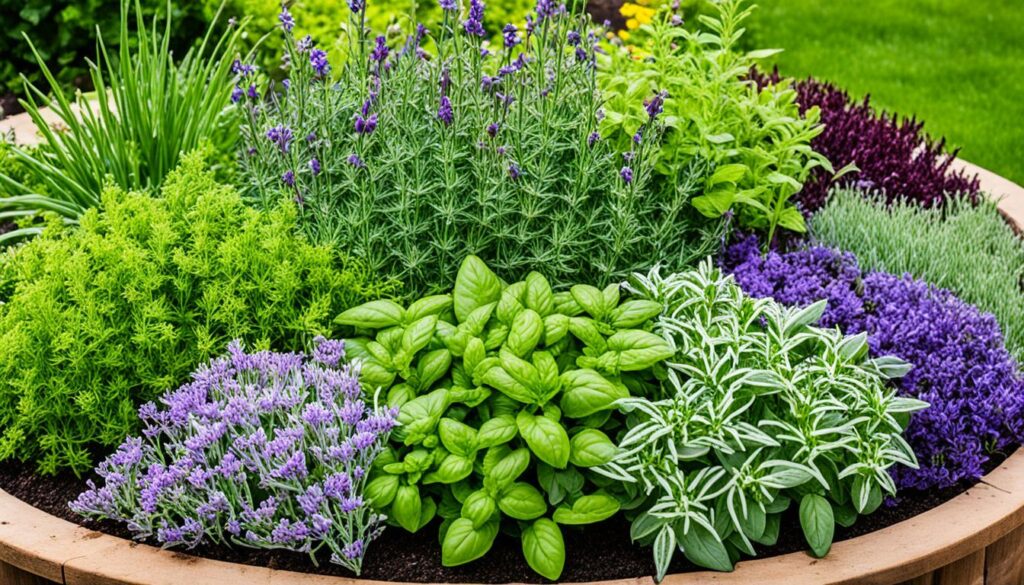
Attracting Beneficial Insects
Planting herbs and flowers can help attract beneficial insects to your garden. These insects can naturally control pests. Aromatic plants like parsley, fennel, and cilantro draw in ladybugs, lacewings, parasitic wasps, and hoverflies. These insects eat aphids, caterpillars, and other pests.
Let these plants flower to attract more beneficial insects. The flowers offer nectar and pollen, which are great food for these insects. This encourages them to live and thrive in your garden.
Parsley, Fennel, and Cilantro
Parsley, fennel, and cilantro are not just tasty herbs. They also help control pests naturally. These plants have small flowers that ladybugs, lacewings, and parasitic wasps love. These insects eat pests like aphids, caterpillars, and mites.
- Parsley attracts hoverflies, which lay eggs near aphids. Their larvae eat the aphids.
- Fennel is a favorite of lacewings. Their larvae eat aphids and mealybugs.
- Cilantro draws parasitic wasps. These wasps lay eggs inside caterpillars, controlling their numbers.
By using these beneficial insects, you can cut down on chemical pesticides. This makes your garden more sustainable and eco-friendly.
Planning Your Companion Planting Strategy
When planning your companion planting strategy, think about what each plant needs and how they work well together. Make sure they like the same amount of light, water, and soil. This way, they’ll grow well together, making your garden healthy and full of life.
Considering Plant Needs and Compatibility
Start by looking at your garden’s conditions like sunlight, moisture, and soil type. Then, find plants that like the same things. For example, put sun-loving herbs like basil, mint, and rosemary with veggies that also need lots of sun. This helps everyone grow better together.
Inspecting Plants and Removing Infested Ones
Checking your plants often is key to a pest-free garden. Look for signs of pests like leaves that are not their usual color, eaten leaves, or bugs. If you find a plant that’s really infested, take it out right away to stop the problem from getting worse. This keeps your companion planting strategy working well.
| Plant Needs | Companion Planting Compatibility |
|---|---|
| Light Requirements | Match sun-loving plants with other sun-loving varieties |
| Water Needs | Pair plants with similar watering requirements |
| Soil Type | Choose plants that thrive in the same soil conditions |
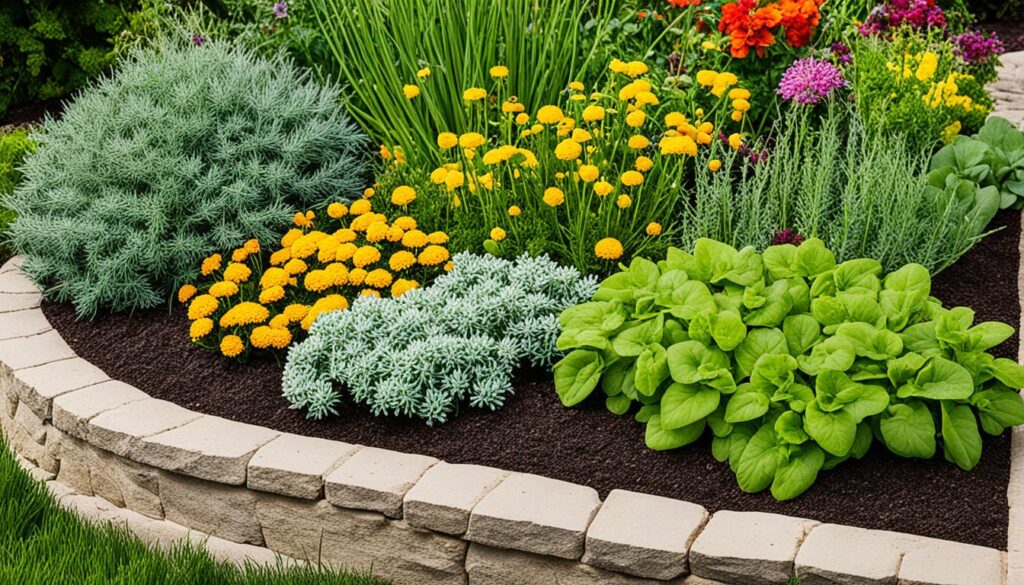
Plan your companion planting strategy well, think about how plants fit together, and watch for pests. This way, you can have a garden that’s full of life and keeps pests away naturally.
Conclusion
Using companion planting can make your garden pest-free without harmful chemicals. By mixing different herbs, flowers, and vegetables, you can keep pests away and attract helpful insects. It might take some trial and error to find the best plant combinations for your garden. But, the long-term benefits of companion planting are worth it for a sustainable, natural pest control.
As you keep improving your companion planting skills, you’ll see a balanced garden ecosystem. Pests will be kept in check, and helpful creatures will flourish. With time and attention, you can cut down on harmful pesticides. This way, you’ll enjoy a pest-free garden that’s full of life.
Now, you know the main ideas and perks of companion planting. You can turn your garden into a lively, eco-friendly haven. Let the variety of plants work together to protect your garden from pests. Enjoy the benefits of a rich, healthy harvest.
FAQ
What are the principles of companion planting for pest control?
The main ideas are: 1) Having more plant types means fewer pests, and 2) Some plants can keep pests away or attract good bugs that eat garden pests.
What are some common herbs that can be used as companion plants to deter pests?
Herbs like mint, tansy, catnip, wormwood, dill, basil, parsley, fennel, and cilantro can keep insects away from vegetables when planted together.
What flowers are effective at attracting beneficial insects to the garden?
Flowers such as nasturtiums, marigolds, cosmos, and alyssum attract ladybugs, lacewings, parasitic wasps, and other good bugs that eat garden pests.
How can I test different companion planting combinations in my garden?
Try pairing thyme, nasturtium, and onion to keep away cabbage worms, or marigold and nasturtium to stop squash bugs. Watch how they do and change things as needed.
Why is it important to avoid using pesticides when practicing companion planting?
Pesticides can hurt good bugs too, upsetting the garden’s balance. Use manual removal, row covers, and healthy soil instead.
What other herbs can be used for natural pest control in the garden?
Herbs like basil, mint, rosemary, lavender, oregano, and thyme can keep away flies, mosquitoes, cabbage worms, and aphids.
How can I attract more beneficial insects to my garden?
Planting parsley, fennel, and cilantro can bring in ladybugs, lacewings, parasitic wasps, and hoverflies that eat garden pests.
What should I consider when planning my companion planting strategy?
Ensure the plants you pair need the same light, water, and soil. Check your garden often for pests and remove any badly infested plants.
Source Links
Earth-Friendly Gardening: Techniques for a Greener Outdoor Space
Are you ready to make your garden green in a big way? Earth-friendly gardening is more than a trend. It’s a smart way to care for your space and the world. By choosing to garden this way, you do less work, save cash, and help the planet. Your garden gets healthier, too.
Key Takeaways:
- Earth-friendly gardening is a practical and sustainable approach to landscaping.
- Sustainable gardening practices can reduce your workload and save money.
- By adopting earth-friendly gardening techniques, you can minimize your environmental footprint.
- Sustainable gardening improves the overall health of your garden.
Are you ready to revolutionize your garden with sustainable practices that benefit both your plants and the planet?
Welcome to the world of earth-friendly gardening! In this section, we’re going to talk about sustainable gardening. We’ll show you how it helps both the environment and your plants.
Earth-friendly gardening focuses on sustainability. It aims to create a balance where nature and people can flourish together. By using sustainable practices, we can use less resources, cut down on waste, and protect many kinds of life. This makes your outdoor space greener and helps the planet.
Why should you try sustainable gardening? We’ll look at its benefits now.
1. Environmental Impact: Sustainable gardening cuts down on chemicals and synthetic fertilizers. This reduces pollution and helps wildlife.
2. Soil Health: Practices like composting and mulching make soil fertile. Healthy soil is key for a great garden!
3. Water Conservation: Techniques like rainwater harvesting save a lot of water. This is good for the planet and your water bill.
4. Cost Savings: Using organic methods can help you spend less on fertilizers, pesticides, and water.
5. Beauty and Harmony: Sustainable gardens are beautiful. They create an outdoor space that looks good and is eco-friendly.
6. Connection with Nature: Sustainable gardening helps you connect with nature. It lets you appreciate the natural world more.
Excited to make your garden more eco-friendly? Next, we’ll cover sustainable gardening’s principles and techniques. We’ll discuss water conservation, organic gardening, biodiversity, and more. Get ready to make your outdoor space greener!
The Foundation of Earth-Friendly Gardening
What is a Sustainable Garden?
Understanding earth-friendly gardening starts with knowing what a sustainable garden is. It uses environmental stewardship principles. Its goals include using fewer non-renewable resources and lessening ecosystem harm. Instead of synthetic fertilizers and lots of water, it uses organic methods, supports many living things, and saves water.
A sustainable garden cares for the environment and keeps going with little outside help. It looks after plant, soil, and wildlife health, making a balanced ecosystem. By working with nature, it not only does well itself but also helps the bigger ecosystem.
Building a sustainable garden means adding several things and methods. These involve:
- Native plants: Picking local plants helps area wildlife and cuts down on water and chemical use.
- Composting: Kitchen leftovers and garden trimmings make compost, feeding the soil and cutting down synthetic fertilizer use.
- Water-wise irrigation: Using smart watering, like drip irrigation or collecting rain, saves water and reduces waste.
- Natural pest control: Attracting helpful insects and birds handles pests without chemicals.
- Soil health: Keeping soil healthy with mulching, rotating crops, and covering the soil supports plant life and strength.
Check out this table to see the important parts of a sustainable garden:
| Elements of a Sustainable Garden | Description |
|---|---|
| Native plants | Choosing plants fit for the local weather and soil saves water and supports different life forms. |
| Composting | Turning waste into compost enriches the soil and reduces the need for artificial fertilizers. |
| Water-wise irrigation | Smart watering methods like drip systems and collecting rain cuts down on water use. |
| Natural pest control | Inviting insects and birds that eat pests naturally reduces chemical pesticide use. |
| Soil health | Improving the soil with mulching, planting different crops in turn, and ground cover helps plants grow better. |
With a sustainable garden, you can have a lively outdoor area that’s good for the environment. Next, we’ll explore more about how to make and care for an earth-friendly garden.
Water Conservation Techniques
Water conservation is key for earth-friendly gardening. You can cut down on water use and still have a great garden. Let’s look at ways to use less water and save this vital resource.
Gathering rainwater is a smart move. You can collect and store rainwater by setting up a rain barrel or a system. This helps you use less tap water and stops runoff and erosion.
Using smart irrigation is crucial for saving water in gardens. Systems like drip irrigation give water right to plant roots, which cuts down waste. Setting a timer for early morning or late evening can also help reduce evaporation.
Mulching is another great water-saving tip. It keeps the soil moist by stopping water from evaporating. Put a layer of organic mulch around your plants to help keep water in the soil.
Choosing the right plants can also save water. Go for plants that need less water and are right for your area. Also, plant things with the same water needs close to each other. This makes watering more efficient.
Keep an eye on your garden’s water use, too. Check for leaks in your watering systems and fix them fast. Catching leaks early helps stop water from being wasted.
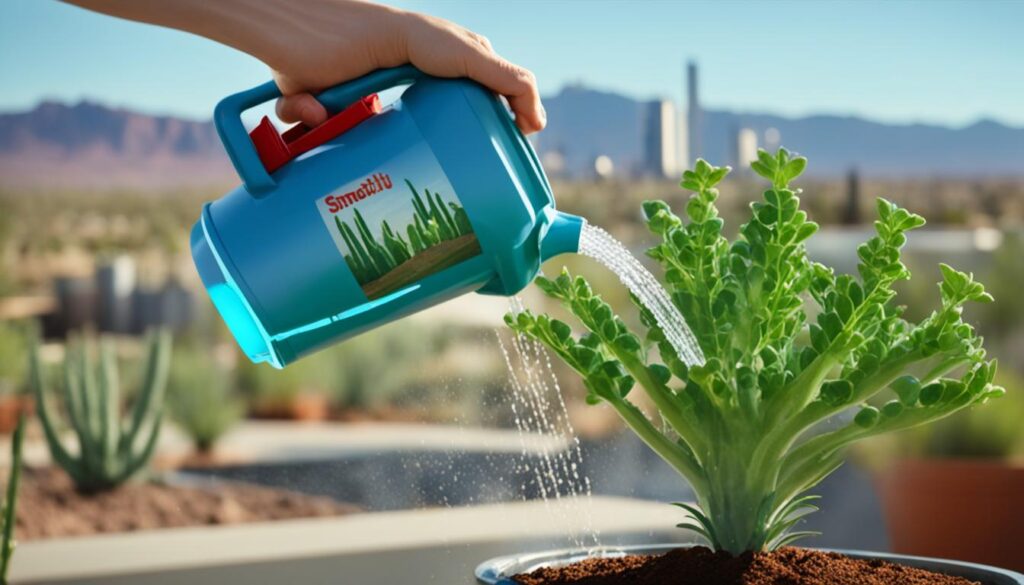
Using these tips, you can cut back on water in your garden. This makes your outdoor space more sustainable and good for the planet.
| Technique | Benefits |
|---|---|
| Collecting rainwater | – Reduces reliance on municipal water supplies – Prevents stormwater runoff and erosion |
| Efficient irrigation methods | – Minimizes evaporation and waste – Optimize watering times |
| Mulching | – Reduces evaporation and maintains soil moisture – Improves soil health |
| Proper plant selection | – Reduces water requirements – Supports local ecosystems |
| Regular maintenance | – Prevents water waste from leaks – Ensures efficient water usage |
Organic Gardening Methods
Organic gardening helps our planet. It lets you grow a beautiful garden without bad chemicals. We’ll see why organic gardening is good and how to do it.
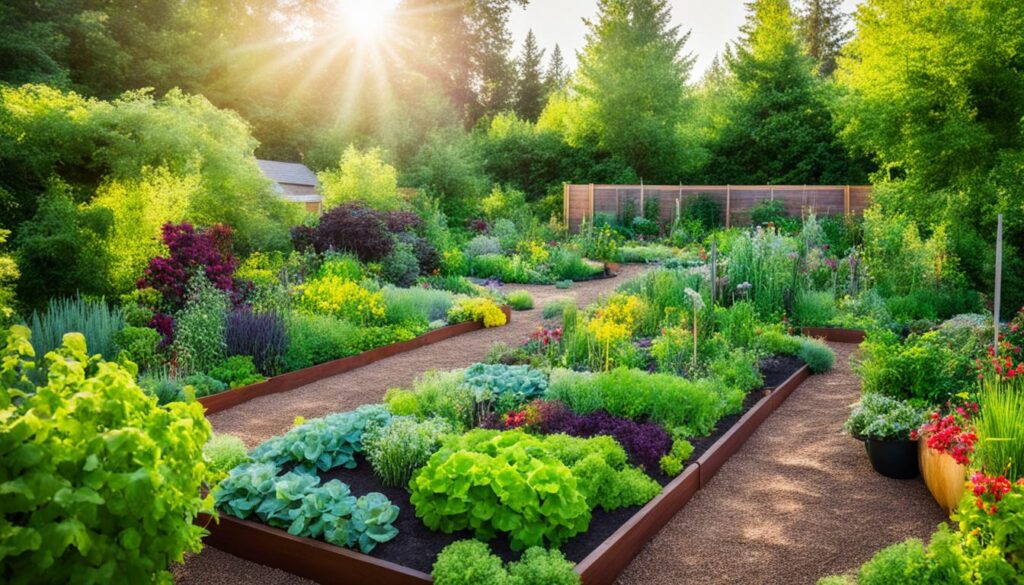
“Organic gardening is more than just growing plants without synthetic chemicals. It’s about nurturing and supporting the natural processes that sustain life.”
Organic gardening has great benefits:
- 1. Environmental Safety: It makes a healthy place by avoiding harmful chemicals. This helps wildlife and keeps water clean.
- 2. Healthier Produce: Foods grown organically are safe and full of nutrients. They’re better for you and your family.
- 3. Soil Health: This kind of gardening makes the soil strong and fertile. Healthy soil means a better garden.
- 4. Biodiversity: Organic gardens welcome bees, friendly bugs, and animals. They don’t use chemical bug killers.
Now, here’s how to garden organically:
- Choose Organic Seeds or Starts: Pick seeds or starts that are organic. This makes sure your plants are safe and natural.
- Improve Soil Quality: Add things like compost or old manure to your soil. This makes it better for your plants.
- Natural Fertilizers: Feed your plants with organic stuff like compost tea. This keeps the soil healthy for a long time.
- Companion Planting: Grow plants like marigolds or basil together. This keeps pests away and brings in good bugs.
- Biocontrols: Use bugs like ladybugs to fight pests. They help without needing chemicals.
- Mulch: Use organic mulch around plants. It stops weeds and keeps soil moist.
Using these tips, your garden can be safe and full of life. Enjoy gardening with nature’s help!
Encouraging Biodiversity
Biodiversity is key for a healthy and strong garden. By bringing more biodiversity to your garden, you make it prettier. You also help the planet stay healthy.

- Plant native species: Native plants fit well with the local weather. They give food and homes to local animals.
- Create wildlife habitats: Add things like birdhouses, bat boxes, and bee hotels. They draw lots of different animals.
- Provide water sources: Put in a bird bath, pond, or small water spot. It will attract birds, bugs, and others.
- Attract beneficial insects: Grow flowers that pull in pollinators like bees and butterflies. This also brings in bugs that eat pests.
- Plant a diverse range of species: Use plants of many sizes, shapes, and bloom times. This draws a big mix of wildlife to your garden.
By welcoming more biodiversity, you make your garden thrive. It will support many kinds of plants and animals.
Reducing Your Garden’s Carbon Footprint
Making your garden more sustainable is key. We’ll talk about how gardens add to carbon emissions. We’ll also give tips to reduce your garden’s impact. Using sustainable designs and eco-friendly materials helps.
Eco-Friendly Garden Maintenance
Maintaining an eco-friendly garden means using sustainable ways all year. By following these tips for eco-friendly garden care, you keep your garden green:
- Proper pruning techniques: Pruning is key in keeping a garden healthy. By pruning selectively, you remove only the bad parts. This helps with airflow and lowers pest risks. Always use clean, sharp tools and sterilize them after each cut to stop disease spread.
- Responsible use of garden tools and equipment: Whenever you can, use hand tools like pruners and weeders. They use less energy. If you need power tools, go for those that are electric or battery-run. They are quieter and pollute less than gas ones.
- Effective waste management: Don’t throw away organic waste such as leaves. Compost them to reduce landfill waste and make good soil. Also, consider leaving grass clippings on your lawn. They break down and feed the grass naturally.
Small changes in how you care for your garden can help the planet. Using these green techniques makes your garden and the earth healthier.
Comparison of Garden Tools
| Tool Type | Advantages | Disadvantages |
|---|---|---|
| Manual Tools | Low energy consumption Quiet operation No air pollution |
Requires physical effort Not suitable for large areas |
| Electric Tools | Lower noise levels compared to gas-powered tools No direct emissions |
Dependency on electricity Limited mobility due to cord length or battery life |
| Gas-Powered Tools | Greater power for heavy-duty tasks Longer running time |
Noise pollution Direct emissions of pollutants More maintenance |
Inspiring Examples of Earth-Friendly Gardens
Want to make your garden eco-friendly? Look at these sustainable gardens. They show how to be green in any space. From tiny city lots to big suburban areas.
The Field of Dreams is in the city. It proves small places can become green havens. It uses vertical plants, pots, and collects rainwater. This makes it productive but eco-friendly.
The Green Haven is great for those with more land. It has native plants, rain gardens, and special paving. These choices help wildlife, save water, and stop flooding. Recycled paths and solar lights add to its green touch.
Meadowsong Sanctuary is out in the countryside. It follows permaculture and regenerative farming. This means it supports itself. It uses natural ways to keep pests away and plants that help each other. It also welcomes animals.
For more eco-gardening tips, visit the Royal Horticultural Society. They have a guide full of ideas. It helps make gardens both pretty and green.
Conclusion
Earth-friendly gardening is more than just a trend. It’s a smart way to design your outdoor space. It helps the planet and makes your garden better. You will work less, save money, and help nature.
This guide showed you how to garden in a planet-friendly way. We talked about saving water and avoiding chemicals. Encouraging various plants and animals is also key.
Now, it’s your turn to try these green gardening methods. By doing this, you help our planet and get a lovely garden. So, put on your gardening gloves. Let’s take a step towards eco-friendly gardening together!
FAQ
What is earth-friendly gardening?
It’s gardening in a way that helps the planet. This means using less water and avoiding harmful chemicals. It also means growing plants that help the environment.
Why is earth-friendly gardening important?
This type of gardening has many benefits. It saves water and helps the soil. It also makes your garden a healthier place. Plus, it’s good for the earth.
How can I conserve water in my garden?
To save water, collect rainwater and choose smart watering systems. Use mulch to keep soil moist. Also, grow plants that don’t need much water.
What are organic gardening methods?
Organic gardening means using natural stuff to help your garden grow. This includes things like compost and avoiding man-made chemicals. It keeps your garden and the earth healthier.
How can I encourage biodiversity in my garden?
For more biodiversity, grow local plants and make homes for wildlife. Also, attract helpful bugs and animals. This makes your garden full of life and good for nature.
How can I reduce my garden’s carbon footprint?
Use eco-friendly designs and materials in your garden. Compost your waste and cut down on gas tools. These steps help your garden pollute less.
What are some eco-friendly garden maintenance practices?
Keep your garden green by pruning correctly and using efficient tools. Also, handle waste the smart way. These practices keep your garden healthy and green all year.
Can you provide examples of earth-friendly gardens?
Yes! There are many great examples out there. They show how to garden in ways that are good for the earth. You can find ideas for your own garden by looking at these examples.
Source Links
- 10 Must-Have Blooms for Your 2025 Garden
- The Health Advantages of Gardening You Need to Know
- How to Create a Small Vegetable Garden Layout Plan: A Beginner’s Guide
- DIY Garden Projects for Small Spaces: Upcycling Ideas to Maximize Your Garden
- Watering Techniques for Small Gardens: Ensuring Your Plants Thrive
- Small Border Plants for Landscaping: Adding Beauty and Functionality to Your Garden
- Year-Round Small Space Gardening: Seasonal Planting Tips for Maximum Harvest
- Essential Tools for Small-Space Gardening: What You Really Need
- The Ultimate Guide to Container Vegetables: What to Grow in Small Spaces
- Budget-Friendly Gardening: How to Create a Thriving Garden on a Tight Budget
- How to Optimize Sunlight in Small Gardens: Tips for Better Plant Growth
- DIY Vertical Planters: Creative Ideas for Small Space Gardening
- Companion Planting for Small Vegetable Gardens: Boost Growth and Deter Pests
- Container Gardening Essentials: Choosing the Right Pots, Soil, and Plants
- Vertical Gardening Techniques: Maximizing Your Small Space with Climbers and Vines
- How to Build a Raised Bed Garden in a Small Backyard: Step-by-Step Guide
- The Best Vegetables for Small-Space Gardens: High-Yield Varieties You Need to Grow
- Smart Vegetable Garden Layouts for Small Spaces: Maximizing Your Green Thumb in Compact Areas
- 40. Best Practices for Managing a Sustainable Garden Year-Round
- Building a Wildlife Pond for Biodiversity
- Advanced Techniques in Sustainable Gardening
- How to Create a No-Till Garden
- The Mental Health Benefits of Gardening
- Using Technology to Enhance Sustainable Gardening
- Getting Certified Organic: Steps and Benefits

